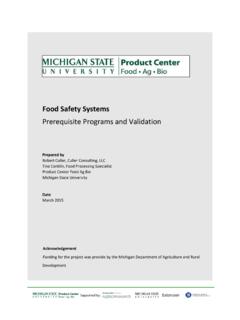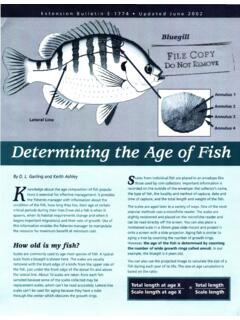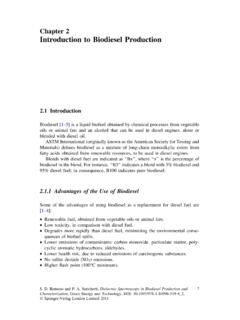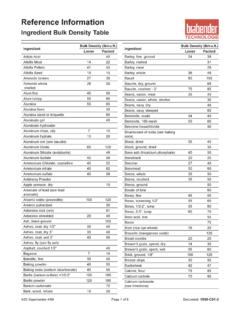Transcription of Distiller’s Dried Grains with Solubles
1 Third EditionTThird EditionDistiller s Dried Grains with Solubles (DDGS)A GUIDE TOTable of Contents Executive Summary Chapter 1 Introduction to DDGS Chapter 2 Ethanol Production and Its Co-Products - Dry-Grind and Wet Milling Processes Chapter 3 Ethanol Production and Its Co-Products - Front-End Fractionation and Back-End Oil Extraction Technologies Chapter 4 Nutrient Composition and Digestibility of DDGS: Variability and In Vitro Measurement Chapter 5 Recommended Laboratory Analytical Procedures for DDGS Chapter 6 Comparison of Different Grain DDGS Sources Nutrient Composition and Animal Performance Chapter 7 Physical and Chemical Characteristics of DDGS Related to Handling and Storage of DDGS Chapter 8 Is Color the Only or Best Indicator of DDGS Quality?
2 Chapter 9 Antibiotic Use in DDGS Production Chapter 10 Mycotoxins in DDGS Chapter 11 Mycotoxin Situation with the 2011 Corn Crop and 2012 DDGS Production Chapter 12 Sulfur Concerns and Benefits in DDGS Chapter 13 Feed Safety and Other Possible Contaminants in DDGS Chapter 14 Use of DDGS in Beef Cattle Diets Chapter 15 Use of Reduced-Oil DDGS in Beef Cattle Diets Chapter 16 Is there a Connection Between Feeding DDGS and E. coli 0157:H7 Shedding in Beef Cattle? Chapter 17 Use of DDGS in Dairy Cattle Diets Chapter 18 Use of Reduced-Oil DDGS in Dairy Cattle Diets Chapter 19 Use of DDGS in Poultry Diets Chapter 20 Use of Reduced-Oil DDGS in Poultry Diets Chapter 21 Use of DDGS in Swine Diets Chapter 22 Use of Reduced-Oil DDGS in Swine Diets Chapter 23 Managing Pork Fat Quality When Feeding High Amounts of DDGS to Growing-Finishing Pigs Chapter 24 Use of Enzymes in DDGS Diets for Poultry and Swine Chapter 25 Use of DDGS in Aquaculture Diets Chapter 26 Use of DDGS in Sheep and Goat Diets Chapter 27 Use of DDGS in Horse and Companion Animal Diets
3 Chapter 28 Impact of Diet Formulation Methods and Tools on Assessing Value of DDGS Chapter 29 Factors that Affect DDGS Pricing and Transportation Logistics Chapter 30 Summary of Grains Council Sponsored International Feeding Trials Chapter 31 Frequently Asked Questions about DDGS Chapter 32 Suppliers of Distiller s Dried Grains with Solubles Chapter 33 Glossary of Terms Chapter 34 Website Links Chapter 35 Key Review Articles and Additional Reading Executive Summary This 3rd Edition of the DDGS User Handbook updates our previous editions with information on recent research and experience on DDGS use.
4 This edition also includes several new chapters discussing low fat DDGS now being produced in many ethanol plants. The ethanol industry includes several different plant designs and production technologies, and uses several different Grains as feedstocks for ethanol production including a wide diversity of corn varieties and sources. With the evolving technology for corn fractionation and for oil extraction, the industry produces many different products as DDGS. As a result, no single DDGS commodity exists. This Handbook gives buyers tools they need in developing relationships with DDGS sellers, so that buyers can be confident of the value of the DDGS they purchase.
5 This version of the Handbook is divided into numerous short chapters, which enable readers to find quickly the specific information they are seeking. Those chapters are summarized below -- Introduction to DDGS An Excellent Ingredient for Use in Animal Feeds Recent record high feed ingredient prices around the world are causing animal nutritionists to search for lower cost alternative feed ingredients to minimize the cost of food animal production. Dried distiller s grain with Solubles (DDGS) is an excellent, lower cost alternative feed ingredient that continues to be produced in large quantities by the dry-grind fuel ethanol industry.
6 The high energy, mid-protein, and high digestible phosphorus content of DDGS make it a very attractive, partial replacement for some of the more expensive, traditional energy (corn), protein (soybean meal), and phosphorus (mono- or dicalcium phosphate) used in animal feeds. When DDGS is added to properly formulated feeds, it results in excellent animal health, performance, and food product quality. These attributes, and others, have made DDGS one of the most popular feed ingredients for use in animal feeds around the world. Ethanol Production and Its Co-Products Dry-Grind and Wet Milling Processes Most ethanol plants in the United States are dry-grind facilities which use starch from corn to produce ethanol and the remainder of the corn kernel is used to produce a variety of wet and Dried distillers Grains co-products including DDGS.
7 In dry-grind ethanol production, each bushel of corn ( kg) produces about liters of ethanol, kg of DDGS, and carbon dioxide. Wet mills represent a significant, but smaller proportion of the ethanol industry and produce corn gluten feed, corn gluten meal, and corn germ meal as the primary co-products. Ethanol Production and Its Co-Products Front-End Fractionation and Back-End Oil Extraction Technologies Corn fractionation has been used for many years to produce specialized industrial and food grade products. A relatively small number of dry-grind ethanol plants implemented front-end fractionation technologies to separate the endosperm (starch rich fraction) from the non-fermentable fractions including the germ and bran.
8 Several new corn co-products, including high-protein DDGS were produced using these technologies, but because of poor long-term economic viability of using these technologies, very, few dry-grind ethanol plants are using front-end fractionation technologies today. However, recently back-end oil extraction technologies have become widely adopted by the majority of dry-Executive Summary 2 grind ethanol plants. In this process, approximately one-third of the corn oil is removed from thin stillage prior to producing a reduced-oil DDGS. The resulting DDGS from this process contains 7 to 9 percent crude fat, and has slightly more crude protein and fiber than DDGS produced without oil extraction.
9 Limited scientific information has been published evaluating the impact of reduced-oil on energy content, but all of the currently available information on this topic is summarized for beef, dairy, poultry, and swine in Chapters 15,18, 20, and 22 of this Handbook. Nutrient Composition and Digestibility of DDGS: Variability and In Vitro Measurement The variability in nutrient content and digestibility among DDGS sources can be a challenge when determining economic and feeding value for livestock and poultry. However, new nutritional tools have been developed, including metabolizable energy (ME) prediction equations for DDGS in swine and poultry diets and equations as well as chemical procedures for estimating digestible amino acid content for poultry and swine.
10 Some commercial companies have developed nutritional tools to rapidly, accurately and inexpensively estimate total and digestible nutrient content of specific DDGS sources. Recommended Laboratory Analytical Procedures for DDGS Laboratory analysis of feed ingredients, including DDGS, is important to verify that guaranteed nutritional specifications are met, determine nutrient composition for accurate feed formulation, and to determine the presence and concentration of any potential contaminants. Chapter 5 of this Handbook describes recommended analytical procedures to use when verifying contract specifications for moisture, crude protein, crude fat and crude fiber in DDGS.













